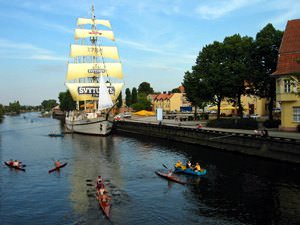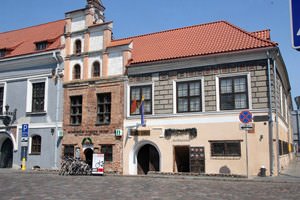 Lithuania is considered a Republic with an industrial agrarian economy. The development of industry plays the dominant role in the economy as the profit from Industrial activities contribute to more than half of the Country’s total Gross Domestic Product. Agriculture on the other hand accounts for about 25%. The Construction and Transportation sector, as well as the Service sector and other types of activities, also contribute significantly towards the development of the State. Industry in Lithuania has been undergoing development since the history of the formation of the Republic. Currently, the most productive sectors are the food and chemical industry, as well as machine building, woodworking, the production of building materials and ready-mix concrete, and metalworking. There is an annual increase in the industrial sector.
Lithuania is considered a Republic with an industrial agrarian economy. The development of industry plays the dominant role in the economy as the profit from Industrial activities contribute to more than half of the Country’s total Gross Domestic Product. Agriculture on the other hand accounts for about 25%. The Construction and Transportation sector, as well as the Service sector and other types of activities, also contribute significantly towards the development of the State. Industry in Lithuania has been undergoing development since the history of the formation of the Republic. Currently, the most productive sectors are the food and chemical industry, as well as machine building, woodworking, the production of building materials and ready-mix concrete, and metalworking. There is an annual increase in the industrial sector.
One of the most popular activities in Lithuania is ecotourism. There are 35 national and regional parks in the country; most of them are of special …
Read further
Read further
1.Lithuania is a member of the EU. Citizens of other states will require a Schengen visa to visit the country. 2. The official currency in Lithuania …
Read further
Read further
 Lithuania consumes at least ten billion kilowatt of electricity per year. Domestic electricity is provided by thermal power plants and hydroelectric power stations. However, only a small part of the energy production is the result of her power material. It should be noted that the country lost a rather large percentage of electricity production after the closure of the nuclear power plant at the request of the European Union. In recent times, the production of electricity by wind stations has been developed. Last year, Lithuania completed the construction of a powerful complex of wind power stations, whose capacity is 60 megawatts. The Bank of Lithuania is the Central bank in the Republic. It should be noted that it is a component of the system of central banks of the Eurozone. About 90% of the total bank capital comprises of foreign deposits. In general, Lithuania maintains a sufficiently rigid banking framework, due to which a balance in the system is maintained. For example, only 9 commercial Lithuanian banks, four branches, and four foreign banks were issued an official banking license. The reserve of the National Bank is about eighteen billion Litas according to data for the previous year.
Lithuania consumes at least ten billion kilowatt of electricity per year. Domestic electricity is provided by thermal power plants and hydroelectric power stations. However, only a small part of the energy production is the result of her power material. It should be noted that the country lost a rather large percentage of electricity production after the closure of the nuclear power plant at the request of the European Union. In recent times, the production of electricity by wind stations has been developed. Last year, Lithuania completed the construction of a powerful complex of wind power stations, whose capacity is 60 megawatts. The Bank of Lithuania is the Central bank in the Republic. It should be noted that it is a component of the system of central banks of the Eurozone. About 90% of the total bank capital comprises of foreign deposits. In general, Lithuania maintains a sufficiently rigid banking framework, due to which a balance in the system is maintained. For example, only 9 commercial Lithuanian banks, four branches, and four foreign banks were issued an official banking license. The reserve of the National Bank is about eighteen billion Litas according to data for the previous year.
Lithuania is an incredibly cozy and quiet country, which is a great place for a family holiday. Due to the compact size of the state, traveling …
Read further
Read further
 The unemployment rate in the country has dropped significantly. At present, it is about twelve percent of the total number of able-bodied population. The average accrued salary according to the data for the previous year was about 783 Euros. The minimum salary for the same year is 380 Euros. The average pension in Lithuania is about 300 dollars. The retirement age for both male and female citizens is 65 years old. It was increased to this figure in accordance with the compulsory requirement of the European Union. At the same time, the monetization of benefits in Lithuania practically did not affect pensioners and the socially unprotected strata of the population. Lithuania’s foreign debt is gradually increasing. Back in the 2000s, it accounted for only 15% of her total GDP. Today, the Country’s foreign debt has reached almost 40% of her total GDP. In 2016, GDP was about 27 billion dollars and the GDP per capita about 7,500 dollars.
The unemployment rate in the country has dropped significantly. At present, it is about twelve percent of the total number of able-bodied population. The average accrued salary according to the data for the previous year was about 783 Euros. The minimum salary for the same year is 380 Euros. The average pension in Lithuania is about 300 dollars. The retirement age for both male and female citizens is 65 years old. It was increased to this figure in accordance with the compulsory requirement of the European Union. At the same time, the monetization of benefits in Lithuania practically did not affect pensioners and the socially unprotected strata of the population. Lithuania’s foreign debt is gradually increasing. Back in the 2000s, it accounted for only 15% of her total GDP. Today, the Country’s foreign debt has reached almost 40% of her total GDP. In 2016, GDP was about 27 billion dollars and the GDP per capita about 7,500 dollars. 

